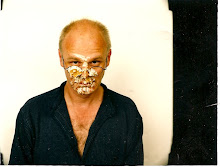The Turner Prize 2009 exhibition at Tate Britain is a show well placed for a recession. Architectural in scale, the work as a whole occupies the vast halls with assurance and balance and refreshingly contains little of the shock, glitz and glamour of past Turner Prize exhibits. This is work about continuity, time and transformation.
Lucy Skaer offers two notable pieces, dramatically different in size but housed in close proximity. Leviathan Edge, the bleached skull of a sperm wale glimpsed through slots cut in the wall backdrop her second piece Black Alphabet. Like a childhood nightmare, the monster peeping through the bedroom curtains with a skeletal leer contrasts the slender forms of the 26 piece, coal dust and resin skittles neatly arranged before it. Like the legs of some anorexic supermodel balanced on delicate hooves Black Alphabet is related to it’s mammalian partner by age and timelessness.
Richard Wright’s vast intricate gold-leaf pattern is worked directly on to the wall at the end of a long, broad space immediately inviting close inspection before stepping backward to take in the whole. Reminiscent of cheap Indian wood block prints on tissue paper the shining gold is both a multiple reflected mandala and exotic landscape of gentle light. The panel seems to invoke a space behind it and confidently stays free of the wall edge. Because this work will have to be painted over it’s ephemeral nature has the momentary impact of a rainbow or sunset.
The stage set created in the next room is all about Enrico David. Even our audience space is interrupted by a Bocsh-like egg figure with the face of the artist pasted on the front. An identical figure perches on the stage with enlarged photographed hands holding the tapered abdomen as if he is about to fart or give birth to another egg – presumably with the same Elvis-like face pasted on the front. I’m not sure what Enrico is telling us here but it seems to be quite a lot about Enrico and not much else. Grotesque theatrical figures view the tableau on one side and the stretched form of a fabric spider-armed man lolls his cardboard face on a montage of printed demonic baby figures. The piece is dominated by a huge cardboard head representing a simplistic phrenological diagram. But guess who’s mind we are introduced to. Enrico apparently thinks chocolate spill and speaks gay builders arse. Although entirely self indulgent there is an absurd playfulness about this when the rest of the show deals with much larger issues.
The brain features in the next room but in a less personal way. Animal brain tissue, presumably mixed with casting wax is used throughout Rogert Hiorns untitled set and employed first to create two alien embryonic forms suspended on a white wall. There is pure transition here on a cosmological scale. A passenger jet engine atomised into a billion grains lays on the floor in black and grey low sculpted dunes. This installation seems to mark a passing moment in endless millennia. The materials used are ephemeral yet constant and deviously specific in their extraction and reconstitution. A bleak dissection of oblivion and hopelessness in which god is a scientist and we are fortunate dust from the laboratory floor.

No comments:
Post a Comment